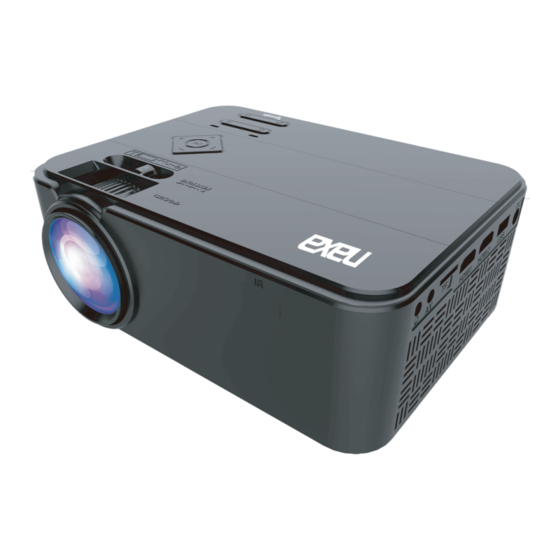
Summary of Contents for Naxa NVP-1000
- Page 1 150” Home Theater LCD Projector NVP-1000 User Manual Please read carefully before using product and keep for future reference...
-
Page 2: Table Of Contents
Table of Contents Introduction............3 Safety Instructions..........4 Additional Warnings..........5 Package Contents..........6 Placing Projector..........7 Making Adjustments.........8 Remote Overview..........9 Projector Overview.........10 Main Operation..........11 Bluetooth Operation........12 HDMI Operation..........14 Audio / Video Input.........15 Computer Video (VGA)........16 External Audio..........17 Micro SD & USB Inputs........18 Specifications..........19 Support............20... -
Page 3: Introduction
Please read this manual carefully and save it for refer- ence. You may also find the latest FAQ, documentation, and other product material at our website. Come visit us on the web at www.naxa.com and see all that we have to offer! -
Page 4: Safety Instructions
Safety Instructions 1. Read these instructions. 2. Keep these instructions. 3. Heed all warnings. 4. Follow all instructions. 5. Do not use this apparatus near water. 6. Clean only with a dry cloth. 7. Do not block any ventilation openings. Install in accor- dance with the manufacturer’s instructions. -
Page 5: Additional Warnings
Additional Warnings 1. Do not look directly into the projector light. 2. Do not touch the projector lens. 3. Mains adapter is used as disconnect and it should remain readily operable during intended use. In order to disconnect the apparatus from the mains completely, the mains plug should be disconnected from the mains socket completely. -
Page 6: Package Contents
Package Contents Projector AC Power Adapter User manual Remote control... -
Page 7: Placing Projector
Placing Projector Your projector can be installed in four different configura- tions (see picture below). Front Table: Select this location with the projector placed near the floor in front of the screen. This is the most common way to position the projector for quick setup and portability. -
Page 8: Making Adjustments
Making Adjustments Follow the pictures below to adjust the focus and trap- ezoidal screen. Adjust the focus by turning the knob while observing the image pixels near the center of the screen. Optimal focus is obtained when the pixels are clearly visible. -
Page 9: Remote Overview
Control Overview... -
Page 10: Projector Overview
Projector Overview 1. Menu Button 12. HDMI Port 1 2. Power Button 13. HDMI Port 2 3. Source Button 14. USB Port 4. Return Button 15. DC IN Jack 5. Netvigator Button 16. VGA Port 6. Trapezoidal ADJ. Knob 17. Power On Indicator 7. -
Page 11: Main Operation
Main Operation... -
Page 12: Bluetooth Operation
Bluetooth® Operation Pairing is the term used when two Bluetooth devices are connected wirelessly for the first time. This allows the devices to see each other and sets up a one-to-one communication channel between both devices. Bluetooth Connection 1. Press the Power button to turn on the unit. 2. - Page 13 NOTE: When the BT can’t connect to this device auto- matically, please enter the Bluetooth setup menu and select to resest BT. Then, the BT device will connect to the projector automatically Disconnecting Bluetooth Device 1. Press the Menu button to enter the menu screen. 2.
-
Page 14: Hdmi Operation
HDMI Operation HDMI offers superior sound and picture quality, and is the easiest way to play media from a computer, Blu-Ray player, or other device with an HDMI output. Requires an HDMI cable (not included) and a device with an HDMI output. 1. -
Page 15: Audio / Video Input
Audio / Video Input Requires a 3.5mm to RCA audio / video cable. 1. Connect the 3.5mm to RCA audio video cable to the AV input on the projector. 2. Connect the 3.5mm to RCA audio / video cable tot he RCA stereo audio outputs and composite video output on the media player. -
Page 16: Computer Video (Vga)
Computer Video (VGA) NOTE: VGA connections do not support audio. You will need to use the computer’s speakers to hear audio. Requires a VGA cable (not included) and a desktop PC or laptop with a VGA output. 1. Using a VGA cable, connect the VGA Input on the projector to the VGA output on your computer. -
Page 17: External Audio
External Audio NOTE: Speakers must have their own power supply. Requires a 3.5mm to RCA audio / video cable. 1. Using a 3.5mm to RCA stereo cable, connect the external powered speakers to the headphone jack on the projector. 2. The projector will automatically detect the connection and send audio signal to the speakers. -
Page 18: Micro Sd & Usb Inputs
Micro SD & USB Inputs Supports Micro SD cards and USB flash drives up to 32GB. Supports AVI, MOV file formats. 1. Load a USB drive into the USB port. 2. Set the Source to Media Player, then use the arrow buttons to select “C:Drive”... -
Page 19: Specifications
Specifications Light Source Type HDMI Input Supported 1080p, 1080o, 720p, 576i, Video Resolution 480p, and 480i Power Consumption Operating 50W; Standby 0.8W Power Input DC 12V, 3.5A Connect Included Adapter Included Adapter Input: AC 100-240V, 50/60Hz Connect DC Input of Unit Output: DC12V, 3.5A Display Color 16.7K... -
Page 20: Support
If you have problems with your device, please consult the instructions in this manual. Please also visit us on the web at www.naxa.com to get up to the minute news, alerts, and documentation for your device. For additional assistance, please contact Naxa Technical Support.









Need help?
Do you have a question about the NVP-1000 and is the answer not in the manual?
Questions and answers